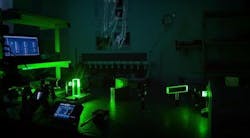Russian scientists develop high-precision picosecond laser for satellite navigation
Scientists from ITMO University (St. Petersburg, Russia) have developed a laser for precise measurement of the distance between the Moon and Earth.1 The short pulse duration and high power of this laser help to reduce error in determining the distance to the Moon to just a few millimeters. This data can be used to specify the coordinates of artificial satellites in accordance with the lunar mass influence to make navigation systems more accurate. Both GPS and GLONASS (Russia's equivalent to GPS) systems are based on accurate measurement of the distance between a terrestrial object and several artificial satellites.
Satellite coordinates must be as accurate as possible to ensure the precise object location. On top of that, the Moon's mass affects satellite trajectories; as a result, lunar coordinates must be taken into account when calculating a satellite's position. The lunar coordinates are obtained by measuring the distance to the Moon with laser locators. The accuracy of such locators depends on the laser features: the shorter the pulse duration and the smaller the laser's beam divergence, the easier it will be to measure the distance between the laser and the Moon.
Scientists from ITMO University's Research Institute of Laser Physics have developed a laser for a lunar locator capable of measuring the distance to the Moon with a margin of error of a few millimeters. The diode-pumped master-oscillator power-amplifier (MOPA) Nd:YAG 1064 nm laser boasts a relatively small size, low radiation divergence, and a unique combination of short pulse duration, high pulse energy, and high pulse repetition rate. The laser's pulse duration is 64 ps. The laser's beam divergence, which determines radiation brightness at large distances, is close to the theoretical limit; it is several times lower than the indicators described for similar devices. The laser system includes a low-order adaptive-optics (AO) subsystem to compensate for thermal distortions; the AO portion includes astigmatic optics and a quadrant photodiode to compensate for the time-dependent wavefront distortions produced in the high-energy laser amplifier.
"Actually, creating a laser with a pulse duration of tens of picoseconds is no longer technically difficult," says Roman Balmashnov, engineer at the Research Institute of Laser Physics and PhD student at ITMO University School of Photonics. "However, our laser's output pulse energy is at least twice higher than that of its analogs. It is 250 mJ at the 'green' wavelength and 430 millijoules at the infrared wavelength. We managed to achieve high pulse repetition rate of 200 Hz and energy stability, so the pulse energy does not vary from pulse to pulse."
The new laser will be used in a lunar laser locator for the GLONASS navigation system. This will make it possible to correct satellite coordinates calculating in real time, making the Russian navigational system more accurate. The margin of error when locating users may be reduced to 10 cm.
"The laser we've developed is cutting-edge by several criteria," notes Andrey Mak, the head of ITMO University's Research Institute of Laser Physics. "According to our data, it is the most powerful pulse-periodic picosecond source of laser radiation in the world. In addition to strictly ranging applications, lasers of this class can be used for imaging of orbital objects: for example, satellites or space debris."
Source: https://www.eurekalert.org/pub_releases/2018-10/iu-rsd100318.php
REFERENCE:
1. A. F. Kornev et al., Optics Letters 43, 4394-4397 (2018); https://doi.org/10.1364/OL.43.004394.
About the Author
John Wallace
Senior Technical Editor (1998-2022)
John Wallace was with Laser Focus World for nearly 25 years, retiring in late June 2022. He obtained a bachelor's degree in mechanical engineering and physics at Rutgers University and a master's in optical engineering at the University of Rochester. Before becoming an editor, John worked as an engineer at RCA, Exxon, Eastman Kodak, and GCA Corporation.

